Geoff Nicholson's Blog, page 36
June 1, 2018
WALKING WHITLEY

I was walking, a couple of weeks back, in Whitley Heights, or perhaps more precisely Hollywood Dell. Whitley Heights was once a very ritzy little enclave in the Hollywood Hills, home to the likes of Bette Davis, Gloria Swanson and Rudolph Valentino. Then they built the Hollywood Freeway and split the area into two - Hollywood Dell is the name given section east and north of the freeway, though I think it still counts as Whitley Heights.
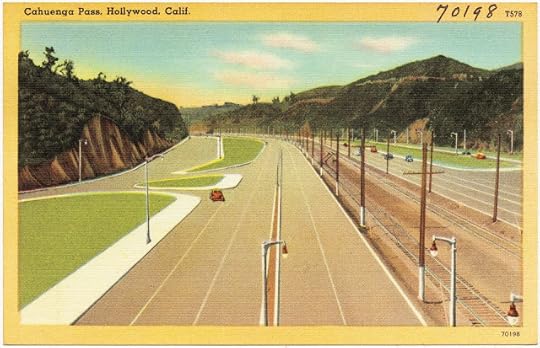
It’s still fairly ritzy in places, a bit funky and hippyish in others. No doubt a few Hollywood types still live there but nobody with the star power of Bette Davis, I think.
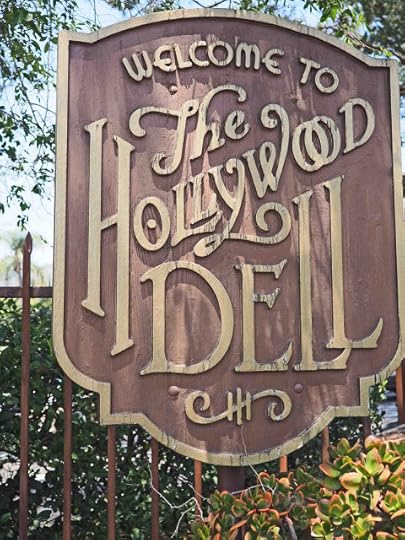
One of the special “only in Hollywood” places to walk by is the Vedanta temple, tucked up against the freeway wall. Vedanta is a form of Hinduism. “All fear and all misery arise from our sense of separation from the great cosmic unity, the web of being that enfolds us,” says the website. Aldous Huxley was a fan, and for a while Christopher Isherwood slept in what’s now the bookshop.

It was a good and interesting walk, and of course, if you have enough obsessions, even minor ones, a quite modest walk can feed quite a few of them. Along the walk I saw a headless Buddha:

Curious flora:

Curious architecture:

An extremely emphatic no parking sign:
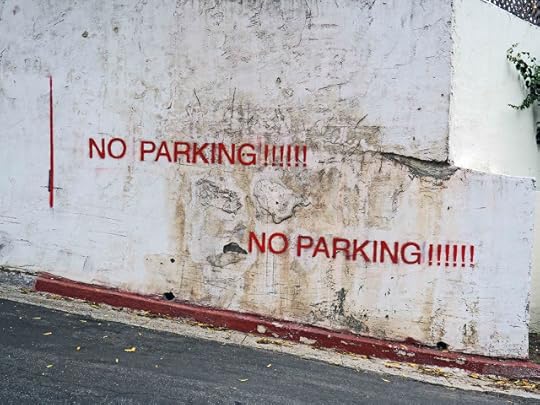
It was also a good walk for spotting Volkswagen Beetles, well only one of them in fact, but it was a beauty, this gorgeously distressed little number:
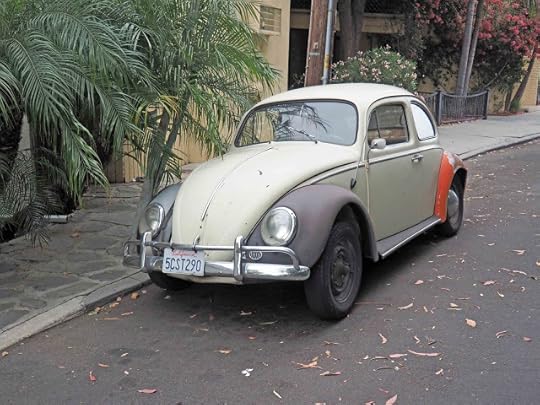
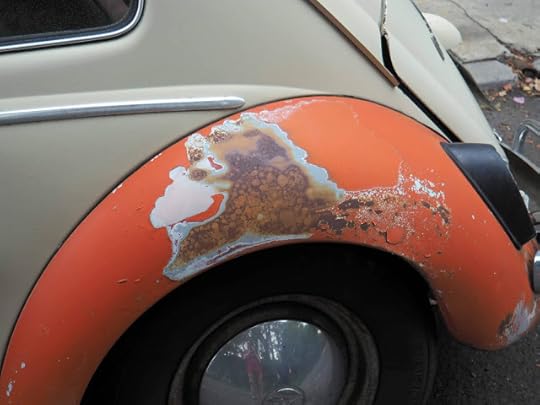
In fact enjoyed the walk so much that I want back and did a longer version of it, although of course I know that you can't walk on the same water twice. Nevertheless I saw more flora and architectural curiosities, in fact at the same time:

And more VWs, wrapped and unwrapped:
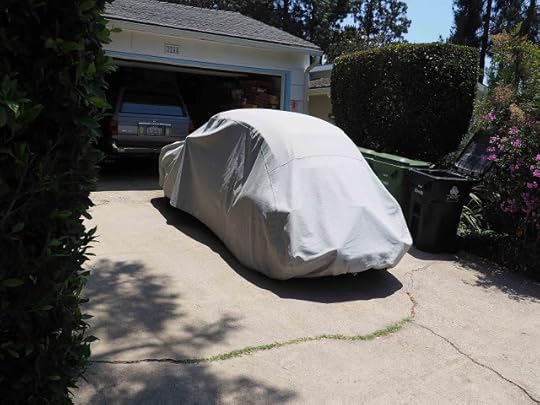

And when I passed the distressed Beetle, the trunk and hood were open, and then a rangy, very friendly, young black man appeared and looked forlornly at the car’s innards. I said it was a fine car – and he agreed, and said it usually ran pretty well, but it had rained earlier in the week and he thought water had got into the electrics. I made sympathetic noises, and I thought about taking the guy’s picture but it didn’t seem the right moment.
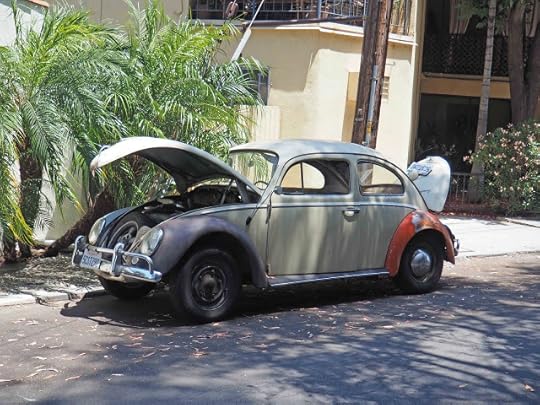
I used to be quite good at dating Volkswagens, but I’ve lost the skill lately. I knew this one was old but I was still surprised and impressed when he told me it was a 1960. You have to have some cojones to drive a 58 year old car in Los Angeles.

Published on June 01, 2018 16:52
May 31, 2018
WALKING LEGIT
A legit auto and a ban on assault weapons – ‘tis a consummation devoutly to be wished, although in the current American climate it seems to be asking rather too much.
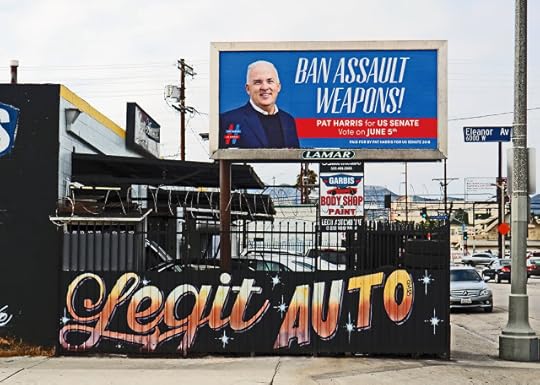
A closer inspection of the picture reveals that this photograph was taken (by me) at the corner of Eleanor Avenue (and Gower). Eleanor Avenue is where Buster Keaton had his movie studio from 1920 and 1928 – not very far from the above spot, at the corner of Eleanor and Lillian.
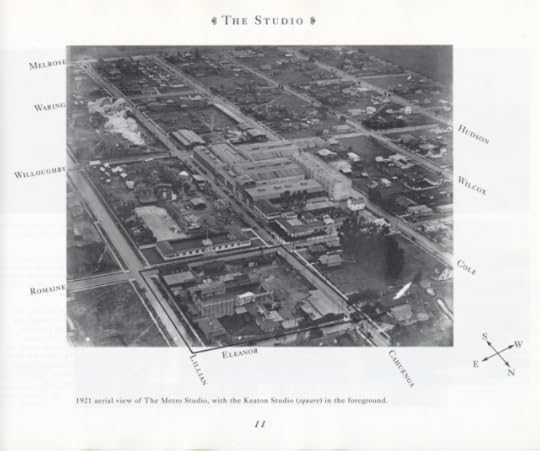
The above image is from Silent Echoes by John Bengtson, a work of superhuman scholarship in tracking down Keaton locations.
Now, in 1940 Keaton married his third wife who just happened to be named Eleanor (nee Norris). She was 23 years his junior and they stayed together until Keaton’s death in 1966. She’s widely credited with saving him from alcoholism and salvaging his career. This is the two of them walking on their wedding day.
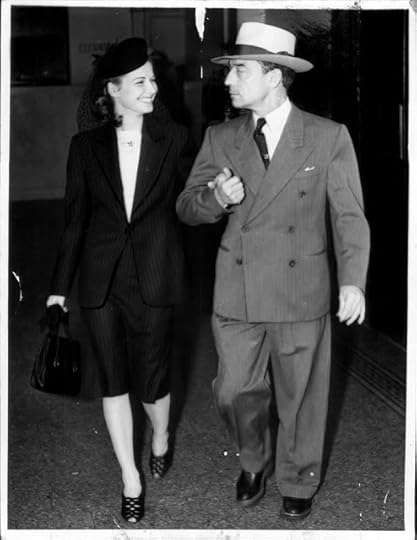
I don’t really imagine that Keaton married her because she shared a name with the street where his studio was once located, although people have married for worse reasons.
Here is a picture of Keaton with a very legit auto.
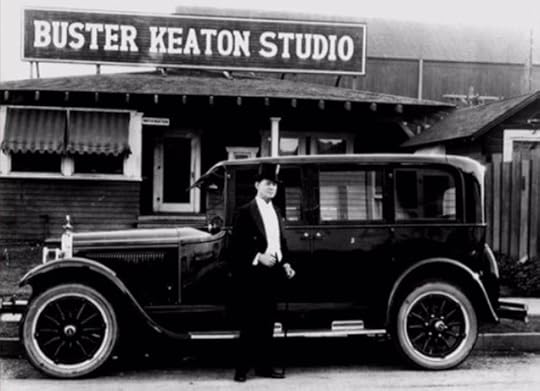
And here with one somewhat less so.
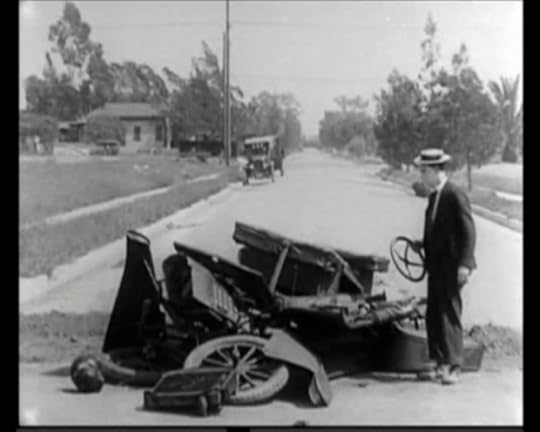


A closer inspection of the picture reveals that this photograph was taken (by me) at the corner of Eleanor Avenue (and Gower). Eleanor Avenue is where Buster Keaton had his movie studio from 1920 and 1928 – not very far from the above spot, at the corner of Eleanor and Lillian.

The above image is from Silent Echoes by John Bengtson, a work of superhuman scholarship in tracking down Keaton locations.
Now, in 1940 Keaton married his third wife who just happened to be named Eleanor (nee Norris). She was 23 years his junior and they stayed together until Keaton’s death in 1966. She’s widely credited with saving him from alcoholism and salvaging his career. This is the two of them walking on their wedding day.

I don’t really imagine that Keaton married her because she shared a name with the street where his studio was once located, although people have married for worse reasons.
Here is a picture of Keaton with a very legit auto.

And here with one somewhat less so.


Published on May 31, 2018 15:19
May 29, 2018
STRIDING WITH SEELIG
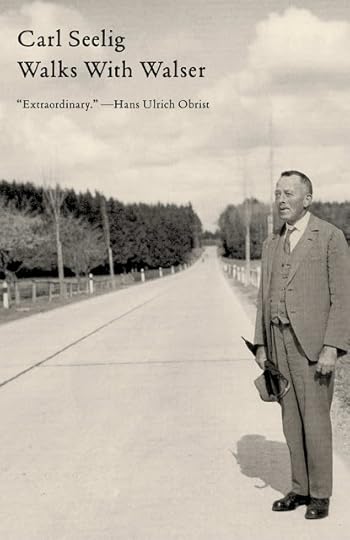
I’ve been reading Walks with Walser by Carl Seelig. Robert Walser (1878 – 1956), has been discussed elsewhere on this blog. He was a German speaking Swiss who published quite a few things in his early life, including the long short story “The Walk,” but spent his last 27 years in a mental asylum. He was eventually celebrated by Susan Sontag and WG Sebald but if it hadn’t been for Carl Seelig, Walser might well have slipped into an obscurity from which he couldn’t be rescued.
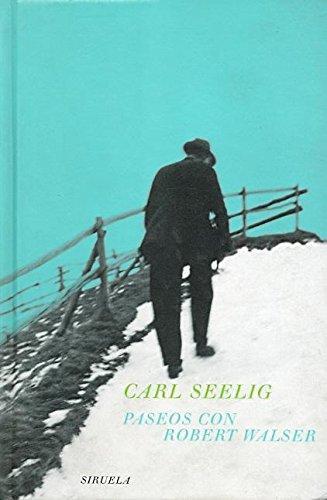
Seelig (1894-1962) was an editor and writer who’d read and admired Walser’s work. He visited him at the asylum, befriended him, promoted his work, and eventually became his literary executor.
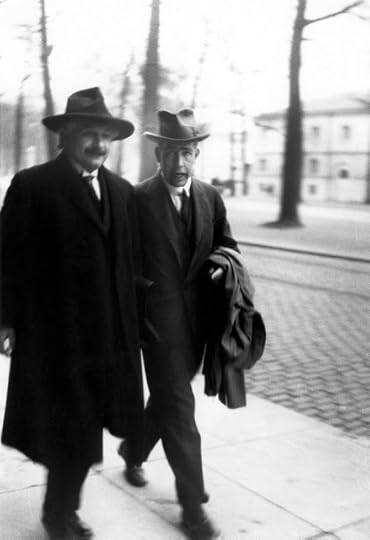 Carl Seelig walking with Albert Einstein
Carl Seelig walking with Albert EinsteinOn these asylum visits, which took place between 1936 and 1956, Seelig took Walser out for a walk and lunch. The book recounts these occasions, and he did some Boswell-style setting down of the things Walser had to say about his life and his work, and about the works of others. Of course there was a war going on for some of this time and Walser was by no means oblivious to events.
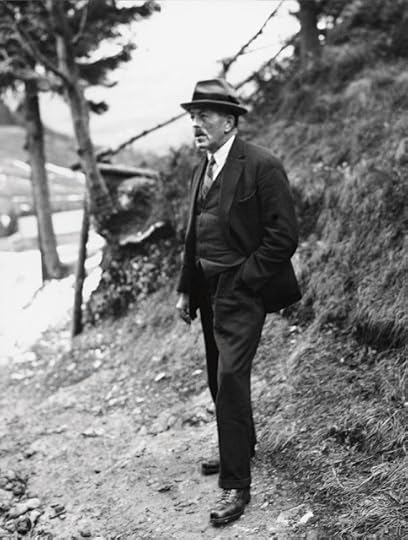
Walser and Seelig sometimes took spectacularly long walks and they had some spectacular lunches. Seelig writes on April 23, 1939,“We make our way from Herisau to Wil in three and a half hours. We feel as if we’re on roller skates.” Well yes. Google maps suggest various routes, but all of them are about 14 miles long, and none of them take less than four and three quarter hours. Anyway, the pair do arrive in Wil, and Seelig writes, “we eat at Im Hof; we are tremendously hungry and stop for a bite at one pub after another. Five in total.”That’s quite a walk. That’s quite a pub crawl.
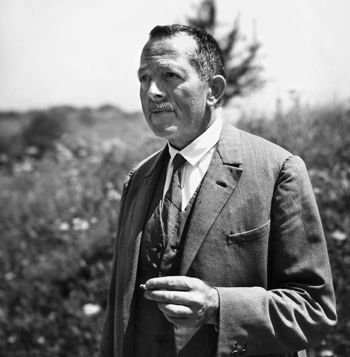
And then on March 21, 1941, Seelig reports Walser as saying, “I tried to visit him (the author and painter Max Dauthendey) in Munich once. But I found only his wife, who told me that her husband happened to be in Wurzburg. I therefore took this as an opportunity to set off in that direction, in light sandals and without a collar. I covered the distance in a little over ten hours. That was the fastest walk I ever took. My feet were full of blisters when I arrived.”I would think so. This time Google has the route as 154 miles long, and they reckon it takes 51 hours to walk, which sounds about right. Even on roller skates Walser’s time seems unlikely.
But perhaps the most interesting thing in that entry is that Walser felt it worth mentioning that he wasn’t wearing a collar. Of all the many items of kit that “serious” walkers find necessary these days, a collar really isn’t one of them. The vast majority of pictures I’ve seen of Walser show him in a three piece suit with a collar and tie, sometimes there’s a hat, but I don’t think I’ve ever seen a photograph of him wearing an overcoat, or anything waterproof, although he does usually carry an umbrella.

Published on May 29, 2018 15:34
May 21, 2018
SOME WAY FROM THE BEACH
I was walking up Beachwood Drive, which leads to Beachwood Canyon, and used to give pedestrian access to the Hollywood sign, although currently it doesn’t: the neighbors complained - they had a point. Not that this deters people from driving up there for a “good look” at the sign.
This is, in many ways, absurd. The sign is visible from miles around, and was in fact designed so that it could be seen from Wilshire Boulevard, which at its nearest point is six and a half miles away.
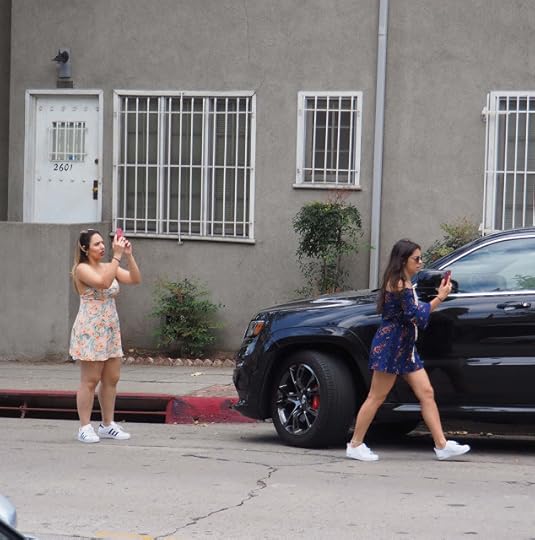
And, of course, tourists always think that Los Angeles is a kind of theme park and so they stand in the middle of the street and take pictures of their friends or themselves with the Hollywood sign looming behind them.
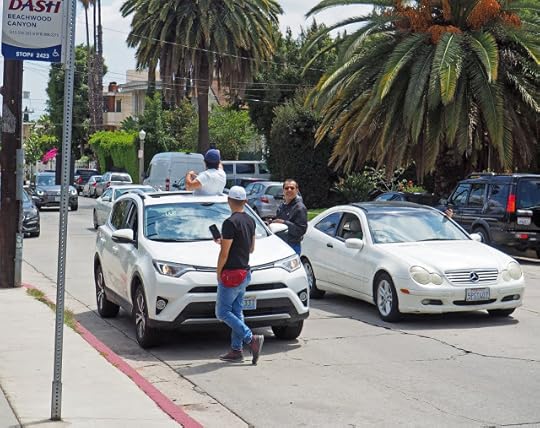
And the most annoying thing of all, nobody ever runs them down, much as I will them to.
Still there are sights to be seen on Beachwood. Obama still rules up there:
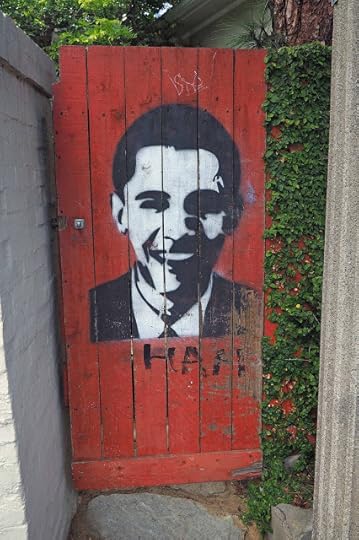
And there are Simpsons-esque amusements:
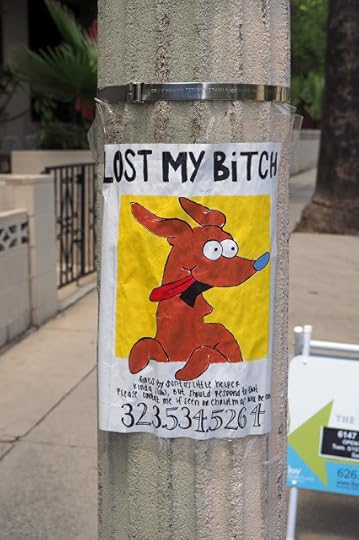
And best of all this house, which admittedly does reinforce the theme park idea, not quite a ruined castle, but close, and I guess it’s being refurbished.
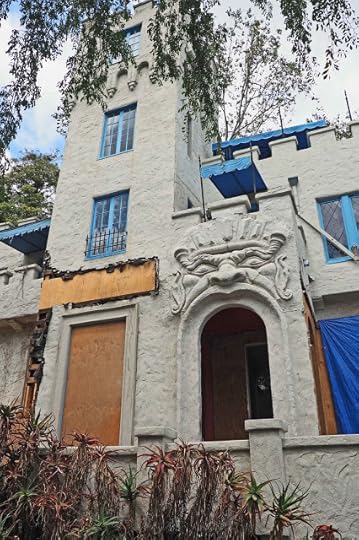
And I do wonder if they’re going to keep that hell’s mouth arch (or possibly porte-cochere) - though I suspect that may make the place harder to sell. It reminds me of the l’Enfer Cabaret (the Surrealist met there occasionally) on Boulevard Clichy, a street I have certainly walked down a few times over the years, though I gather l’Enfer has been a Monoprix supermarket since 1950 or so, which would explain why I never saw it.
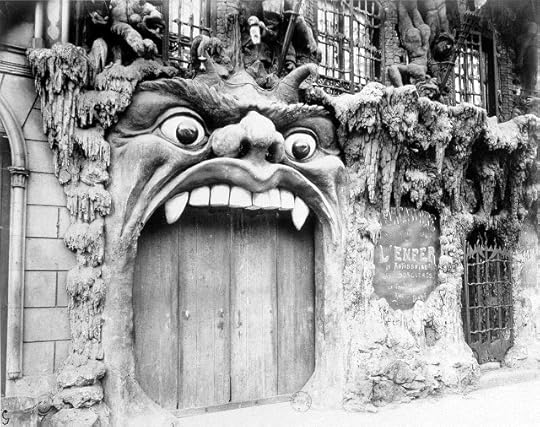
And it also reminds me of this mouth at Bomarzo (the Park of Monsters) where I still have hopes of walking one of these years.
And now, and obviously this is the actual inspiration, Mr. Matthew Licht send me this image of the facade of the Biblioteca Herziana, the German Academy, on Via Gregoriana in Rome.
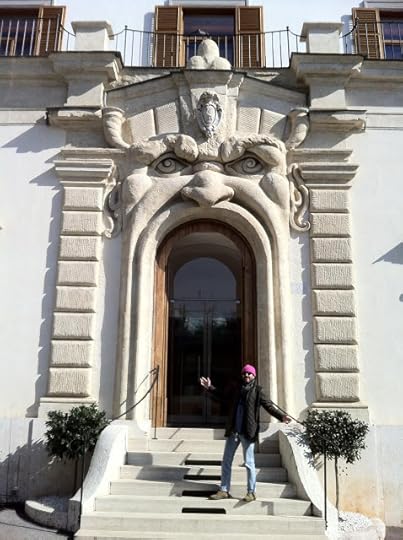

This is, in many ways, absurd. The sign is visible from miles around, and was in fact designed so that it could be seen from Wilshire Boulevard, which at its nearest point is six and a half miles away.

And, of course, tourists always think that Los Angeles is a kind of theme park and so they stand in the middle of the street and take pictures of their friends or themselves with the Hollywood sign looming behind them.

And the most annoying thing of all, nobody ever runs them down, much as I will them to.
Still there are sights to be seen on Beachwood. Obama still rules up there:

And there are Simpsons-esque amusements:

And best of all this house, which admittedly does reinforce the theme park idea, not quite a ruined castle, but close, and I guess it’s being refurbished.

And I do wonder if they’re going to keep that hell’s mouth arch (or possibly porte-cochere) - though I suspect that may make the place harder to sell. It reminds me of the l’Enfer Cabaret (the Surrealist met there occasionally) on Boulevard Clichy, a street I have certainly walked down a few times over the years, though I gather l’Enfer has been a Monoprix supermarket since 1950 or so, which would explain why I never saw it.

And it also reminds me of this mouth at Bomarzo (the Park of Monsters) where I still have hopes of walking one of these years.
And now, and obviously this is the actual inspiration, Mr. Matthew Licht send me this image of the facade of the Biblioteca Herziana, the German Academy, on Via Gregoriana in Rome.


Published on May 21, 2018 17:55
A LONG WAY FROM THE BEACH
I was walking up Beachwood Drive, which leads to Beachwood Canyon, and used to give pedestrian access to the Hollywood sign, although currently it doesn’t: the neighbors complained - they had a point. Not that this deters people from driving up there for a “good look” at the sign.
This is, in many ways, absurd. The sign is visible from miles around, and was in fact designed so that it could be seen from Wilshire Boulevard, which at its nearest point is six and a half miles away.

And, of course, tourists always think that Los Angeles is a kind of theme park and so they stand in the middle of the street and take pictures of their friends or themselves with the Hollywood sign looming behind them.

And the most annoying thing of all, nobody ever runs them down, much as I will them to.
Still there are sights to be seen on Beachwood. Obama still rules up there:

And there are Simpsons-esque amusements:

And best of all this house, which admittedly does reinforce the theme park idea, not quite a ruined castle, but close, and I guess it’s being refurbished.

And I do wonder if they’re going to keep that hell’s mouth arch (or possibly porte-cochere) - though I suspect that may make the place harder to sell. It reminds me of the l’Enfer Cabaret (the Surrealist met there occasionally) on Boulevard Clichy, a street I have certainly walked down a few times over the years, though I gather l’Enfer has been a Monoprix supermarket since 1950 or so, which would explain why I never saw it.

And it also reminds me of this mouth at Bomarzo (the Park of Monsters) where I still have hopes of walking one of these years.

This is, in many ways, absurd. The sign is visible from miles around, and was in fact designed so that it could be seen from Wilshire Boulevard, which at its nearest point is six and a half miles away.

And, of course, tourists always think that Los Angeles is a kind of theme park and so they stand in the middle of the street and take pictures of their friends or themselves with the Hollywood sign looming behind them.

And the most annoying thing of all, nobody ever runs them down, much as I will them to.
Still there are sights to be seen on Beachwood. Obama still rules up there:

And there are Simpsons-esque amusements:

And best of all this house, which admittedly does reinforce the theme park idea, not quite a ruined castle, but close, and I guess it’s being refurbished.

And I do wonder if they’re going to keep that hell’s mouth arch (or possibly porte-cochere) - though I suspect that may make the place harder to sell. It reminds me of the l’Enfer Cabaret (the Surrealist met there occasionally) on Boulevard Clichy, a street I have certainly walked down a few times over the years, though I gather l’Enfer has been a Monoprix supermarket since 1950 or so, which would explain why I never saw it.

And it also reminds me of this mouth at Bomarzo (the Park of Monsters) where I still have hopes of walking one of these years.

Published on May 21, 2018 17:55
May 19, 2018
WALKING WITH SLACK
I recently interviewed the Los Angeles-based photographer Mike Slack for the British Royal Photographic Society. Inevitably a certain amount ended up on the cutting room floor and some of that concerned walking. Mike is creating a series of books with the overall title Walking in Place, in which he walks around various cities, photographing what he sees. The first book featured New Orleans. This is a spread from the book:
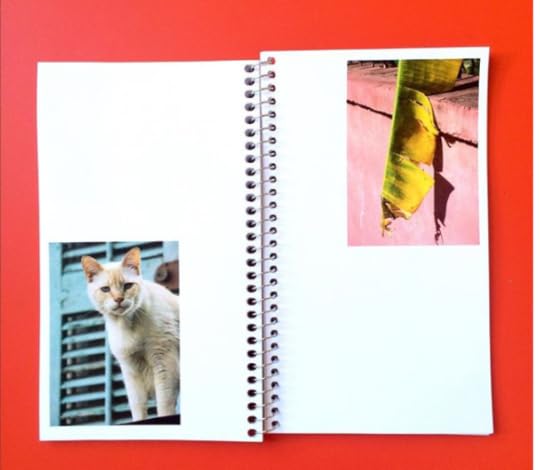
Perhaps inevitably, psychogeography raised its head in our conversation. I’ve learned through experience that when you mention psychogeography to most civilians their eyes just glaze over, so that didn’t make it into the final interview edit either, but here’s how the exchange went:
*GN: I see that notions of walking, maybe psychogeography, pop up in your work. Can you say anything about that?
MS: The aimless wandering aspect has always been a really fruitful method for seeing new things and making new pictures. An increasingly important part of it for me is the randomness, just rolling the proverbial dice and ending up somewhere and zeroing in a specific scene, a picture, at whatever scale, which always seems to link somehow to another specific picture from another time and place, and so on, all of the pictures somehow connected. I don’t know if that’s strictly a psychogeographic approach, but the “game” aspect of it is really appealing, using playful methods to tune into your immediate surrounding, and letting chance dictate the content or pathway. *
The interview has somewhat mysteriously disappeared from the RPS website. When, and if it returns, I'll put a link here.
Meanwhile, here's Mr Slack with an image that appears in the New Orleans book:



Perhaps inevitably, psychogeography raised its head in our conversation. I’ve learned through experience that when you mention psychogeography to most civilians their eyes just glaze over, so that didn’t make it into the final interview edit either, but here’s how the exchange went:
*GN: I see that notions of walking, maybe psychogeography, pop up in your work. Can you say anything about that?
MS: The aimless wandering aspect has always been a really fruitful method for seeing new things and making new pictures. An increasingly important part of it for me is the randomness, just rolling the proverbial dice and ending up somewhere and zeroing in a specific scene, a picture, at whatever scale, which always seems to link somehow to another specific picture from another time and place, and so on, all of the pictures somehow connected. I don’t know if that’s strictly a psychogeographic approach, but the “game” aspect of it is really appealing, using playful methods to tune into your immediate surrounding, and letting chance dictate the content or pathway. *
The interview has somewhat mysteriously disappeared from the RPS website. When, and if it returns, I'll put a link here.
Meanwhile, here's Mr Slack with an image that appears in the New Orleans book:


Published on May 19, 2018 20:04
May 16, 2018
COSMOPOLITAN WALKING
Perhaps you saw, a couple of weeks back, an obituary for Ninalee Allen Craig, who died in Toronto at the age of 90. If the name isn’t immediately familiar, one photograph of her is very famous indeed. It's generally known as "American Girl in Italy."

It was taken in 1951 in Florence by Ruth Orkin. The two women were staying in the same cheap hotel, and Orkin was working on a piece of photojournalism about American women traveling alone in Europe. She enlisted Craig (who was known at that time as Jinx Allen) to be her model. The end result appeared in Cosmopolitan the following year. Some sources say the title of the piece was, “When you travel alone … tips on money, men, and morals,” others say it was “Don’t Be Afraid to Travel Alone.” I’ve not been able to locate the interior of the Cosmo in question and look inside, but I think it’s this one:
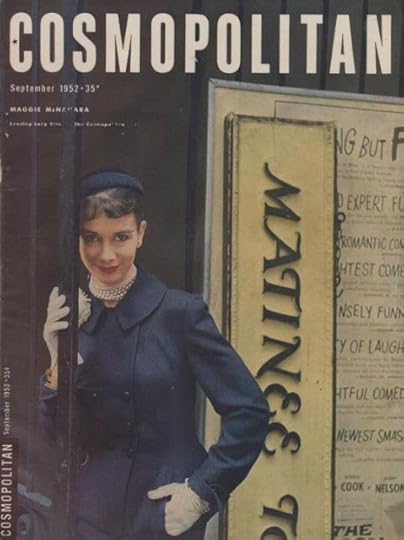
Of course the very fact that single women were being offered advice about traveling alone in Europe in 1952 is some indication of female freedom and independence, even if it was surely a minute number of women who actually did it.
The Orkin photograph seems easy enough to interpret from our current perspective: an attractive single women can’t walk down a street in Florence without being hassled by lecherous Italians, although in fact the magazine caption rather contradicted that. It read, “Public admiration . . . shouldn’t fluster you. Ogling the ladies is a popular, harmless and flattering pastime you’ll run into in many foreign countries. The gentlemen are usually louder and more demonstrative than American men, but they mean no harm.” Well …
In later interviews Ms. Craig also felt the picture showed an essentially benign interaction. “Women look at that picture and feel indignant, angry,” she said. “They say, ‘That poor woman. We should be able to walk wherever we want to and not be threatened.’ As gently as I can, I explain I was not feeling fear. There was no danger because it was a far different time.”
No doubt it was, but there are other issues here too, I think. The image may not strictly speaking be “staged,” but some of those men certainly appear to acting up for the camera. But the real problem is the expression on Jinx Allen’s face. She looks at best uncomfortable and pained, and at worst frightened. And this too may be put on for the sake of the picture – but that only reinforces the problem. Was she actually feeling comfortable but the photographer asked her to look pained for the sake of a good picture?
I don’t know, neither did I know until very recently that there’s a whole bunch of other pictures by Ruth Orkin that show Jinx Allen being a solo tourist. And the fact is she doesn’t look very comfortable in most of them, but again whether this is “natural” or a pose I can’t tell.
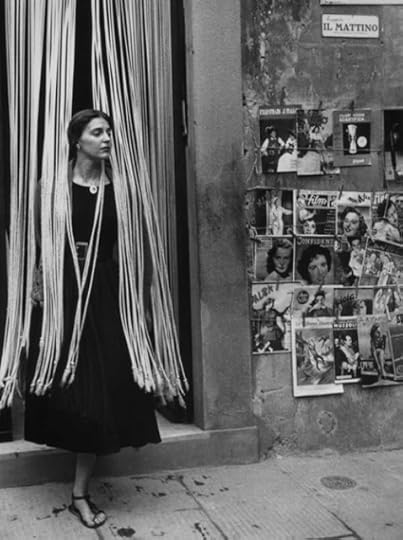
You can see some of the other pictures for yourself on this website run by Ruth Orkin’s daughter:http://www.orkinphoto.com/photographs/american-girl/

It was taken in 1951 in Florence by Ruth Orkin. The two women were staying in the same cheap hotel, and Orkin was working on a piece of photojournalism about American women traveling alone in Europe. She enlisted Craig (who was known at that time as Jinx Allen) to be her model. The end result appeared in Cosmopolitan the following year. Some sources say the title of the piece was, “When you travel alone … tips on money, men, and morals,” others say it was “Don’t Be Afraid to Travel Alone.” I’ve not been able to locate the interior of the Cosmo in question and look inside, but I think it’s this one:

Of course the very fact that single women were being offered advice about traveling alone in Europe in 1952 is some indication of female freedom and independence, even if it was surely a minute number of women who actually did it.
The Orkin photograph seems easy enough to interpret from our current perspective: an attractive single women can’t walk down a street in Florence without being hassled by lecherous Italians, although in fact the magazine caption rather contradicted that. It read, “Public admiration . . . shouldn’t fluster you. Ogling the ladies is a popular, harmless and flattering pastime you’ll run into in many foreign countries. The gentlemen are usually louder and more demonstrative than American men, but they mean no harm.” Well …
In later interviews Ms. Craig also felt the picture showed an essentially benign interaction. “Women look at that picture and feel indignant, angry,” she said. “They say, ‘That poor woman. We should be able to walk wherever we want to and not be threatened.’ As gently as I can, I explain I was not feeling fear. There was no danger because it was a far different time.”
No doubt it was, but there are other issues here too, I think. The image may not strictly speaking be “staged,” but some of those men certainly appear to acting up for the camera. But the real problem is the expression on Jinx Allen’s face. She looks at best uncomfortable and pained, and at worst frightened. And this too may be put on for the sake of the picture – but that only reinforces the problem. Was she actually feeling comfortable but the photographer asked her to look pained for the sake of a good picture?
I don’t know, neither did I know until very recently that there’s a whole bunch of other pictures by Ruth Orkin that show Jinx Allen being a solo tourist. And the fact is she doesn’t look very comfortable in most of them, but again whether this is “natural” or a pose I can’t tell.

You can see some of the other pictures for yourself on this website run by Ruth Orkin’s daughter:http://www.orkinphoto.com/photographs/american-girl/

Published on May 16, 2018 13:26
May 14, 2018
GOOSING AND STEPPING
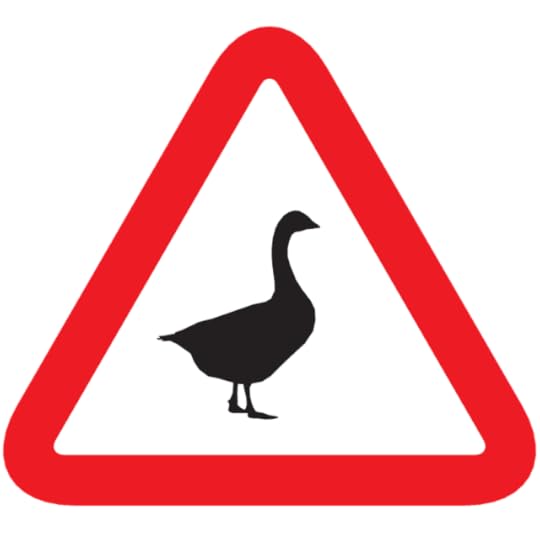
Laura Kipnis is an interesting writer and I think an interesting character, the author of Unwanted Advances: Sexual Paranoia Comes to Campus, about the moment when Liberalism becomes Stalinism, a contrarian perhaps, though most of what she writes makes pretty good sense to me, but that’s probably an argument for another time and place.

Her appearance on a blog about walking, and I realize I’m a bit late on this, is because of a headline I saw on the Sun website that read, “LABOUR PERV - Minister ‘stuck his hand up young woman’s skirt 10 minutes after they met’.” Say what you like those tabloid guys, they know how to write a headline.
The young woman in question is, of course, Laura Kipnis, and the Sun refers to an article she wrote for the Guardian, part of which reads as follows:“The culprit was a future MP and Europe minister, the friend of a friend. We were in a group of people heading into a restaurant, and this guy, later to become so politically illustrious, who was walking behind me, and whom I’d met maybe 10 minutes before, reached forward and goosed me.”
Goosing is a curious word, isn’t it? It sounds kind of friendly and innocent, although I suspect that if you’ve ever been bitten in the bum by a goose you might think otherwise. Kipnis continues, “By goosed, I don’t mean he touched me on my butt, but in my butt, through the thin skirt I was wearing. I turned around and glared at him – I was young, jetlagged, and confused. Was this customary in Britain? What he’d done felt humiliating. I turned ahead and resolutely kept walking, whereupon he did it again.“When I say things turned out well, what I mean is that he later went to prison. The ostensible reason was for cheating on his expenses, but I like to think it was cosmic justice for his crimes against my person.”

The best line here of course is the question “Was this customary in Britain?” And I wonder how different things might have been if goosing had been an old British custom. Would that have made it OK? I don’t think so.

Published on May 14, 2018 19:54
May 13, 2018
WALKING HUBLY

I was walking in Culver City (named after its founder Harry Culver), not a place I go very often, and usually I’m there with a purpose that doesn’t leave me with much time on my hands, but on this occasion I organized things so that I had time for a bit of a drift.I wasn’t looking for anything in particular and a lot of the time I wasn’t exactly sure what I was looking at. I know for example, that this thing below is part of Sony Studios but I don’t know why it’s all wrapped and Christo-ed up like that.
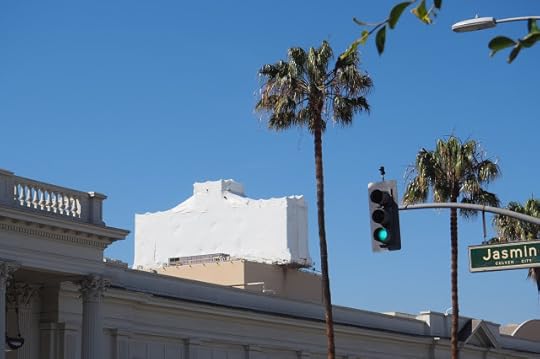
And I assume these giant dishes also have something to do with Sony but lord knows what, and I’ve never seen anything like them on an ordinary city street before. I kind of liked them, unless of course they cause cancer, which I'm sure somebody says they do.

And I definitely had no idea who Saint Rita of Cascia was.

Turns out she was born Margherita Lotti, and lived in the late 14th and early 15th century in Italy. She was a victim of spousal abuse, then a widow, then a nun, and in 1900 a saint, at which point she was given the title Patroness of Impossible Causes. Sounds good to me. She’s also known among some believers as a patroness of abused wives.
And no, I don’t know if there’s a person lurking behind that shopping cart, but there very well might be.
Oh yeah and don’t ask me why any dentist would call their business Picasso Smile:

You see the problem?
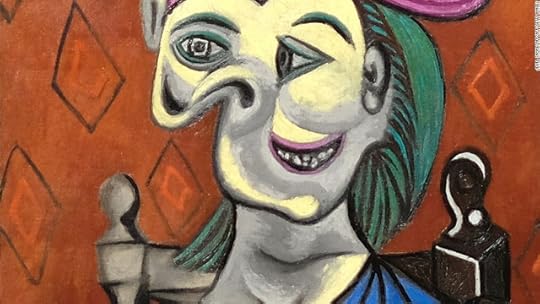
And currently one of great sights of Culver City is a very large hole, which is in fact best viewed from the Metro station platform.

This will be Culver Steps - a huge development featuring 65,000 square feet of office space, and 45,000 square feet of commercial space - I'm not sure I absolutely understand the difference, but I'm sure there is one – Amazon are moving in.
There’ll also be, apparently, a 10,000-square-foot staircase leading to a 10,000-square-foot plaza. It will be, and needless to say I’m quoting here, “a walkable urban hub.” Why does that make me feel so weary?


Published on May 13, 2018 20:37
May 9, 2018
BAREFOOT IN THE PLAZA
Some of us LA urbanists like to complain about the lack of public space. Yes, there are parks – Griffith Park being the main one – 4,210 acres – and it’s a fabulous resource, and of course there’s MacArthur Park op cit, but it’s not the same as those little, unspectacular, out of the way parks I know in London (and to a lesser extent in Paris), places where you can go and read a book or eat your lunch or just sit and think, or not think.
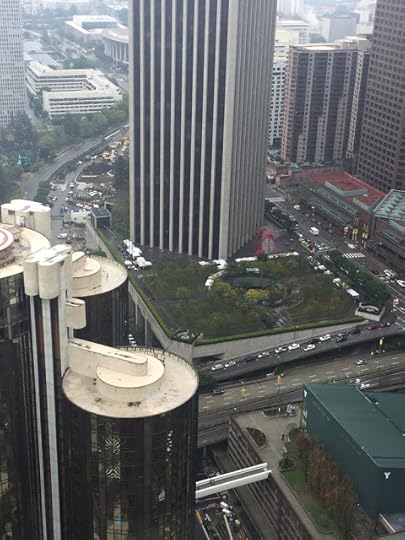
A couple of weeks back I found myself in the Bank of America Plaza, in downtown LA - it's the green rectangle in the photo above - formerly Security Pacific Plaza - and the very name encapsulates all the issues. It’s public space in the sense that anyone can walk in there and nobody stops them, but it’s obviously not part of the public weal because it’s got the Bank of America’s name on it.

Even so, on a Friday afternoon, when there’s a farmer’s market with food stalls, it seemed a pretty decent place to hang out for a while and have something to eat, a break from the Nicholsonian drift. There’s grass, places to sit, a nice water feature, and you get a million dollar view of the Bonaventure Hotel.

I bought my lunch from the Happy Inka: Peruvian food, you won’t be surprised to hear. I had the fish and rice plate, and yes, I did have to dig around in order to find the fish.


It went down pretty well and then I went home, and for most of Friday night it came up – and down – from both ends, and I took to my bed for most of Saturday. I can’t absolutely swear that it was the Peruvian fish that was the cause – I ate other things as well that day - but the next time I’m offered Peruvian fish, the memory (which is coming back strongly as I write this) will definitely make me hesitate.
Researching matters later I discover that the Bank of America Plaza is where Richard Gere wanders barefoot in Pretty Woman – a movie I’ve never been able to face watching – though I often feel as though I have seen it.
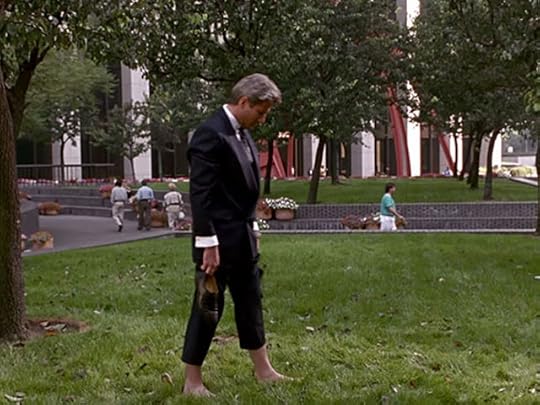
And that got me thinking of Barefoot in the Park, the Neil Simon stage play turned into a movie with Robert Redford and Jane Fonda. She’s a free spirit, he isn’t, though in the end he becomes one, and he walks barefoot (and indeed drunk) in New York’s Washington Square Park as a sign of his newfound free-spiritedness. In this picture Jane keeps her shoes on. The cops look on.
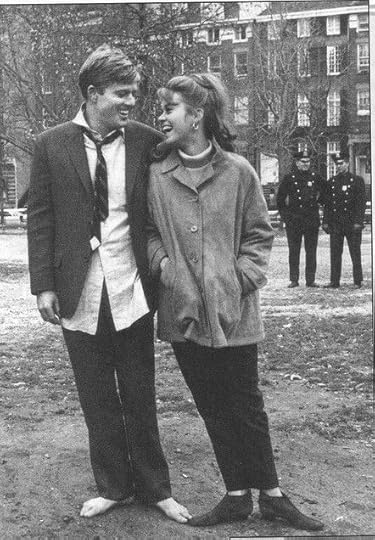


A couple of weeks back I found myself in the Bank of America Plaza, in downtown LA - it's the green rectangle in the photo above - formerly Security Pacific Plaza - and the very name encapsulates all the issues. It’s public space in the sense that anyone can walk in there and nobody stops them, but it’s obviously not part of the public weal because it’s got the Bank of America’s name on it.

Even so, on a Friday afternoon, when there’s a farmer’s market with food stalls, it seemed a pretty decent place to hang out for a while and have something to eat, a break from the Nicholsonian drift. There’s grass, places to sit, a nice water feature, and you get a million dollar view of the Bonaventure Hotel.

I bought my lunch from the Happy Inka: Peruvian food, you won’t be surprised to hear. I had the fish and rice plate, and yes, I did have to dig around in order to find the fish.


It went down pretty well and then I went home, and for most of Friday night it came up – and down – from both ends, and I took to my bed for most of Saturday. I can’t absolutely swear that it was the Peruvian fish that was the cause – I ate other things as well that day - but the next time I’m offered Peruvian fish, the memory (which is coming back strongly as I write this) will definitely make me hesitate.
Researching matters later I discover that the Bank of America Plaza is where Richard Gere wanders barefoot in Pretty Woman – a movie I’ve never been able to face watching – though I often feel as though I have seen it.

And that got me thinking of Barefoot in the Park, the Neil Simon stage play turned into a movie with Robert Redford and Jane Fonda. She’s a free spirit, he isn’t, though in the end he becomes one, and he walks barefoot (and indeed drunk) in New York’s Washington Square Park as a sign of his newfound free-spiritedness. In this picture Jane keeps her shoes on. The cops look on.


Published on May 09, 2018 18:03
Geoff Nicholson's Blog
- Geoff Nicholson's profile
- 55 followers
Geoff Nicholson isn't a Goodreads Author
(yet),
but they
do have a blog,
so here are some recent posts imported from
their feed.



